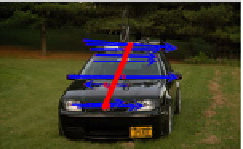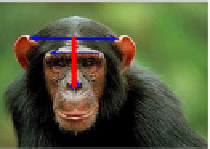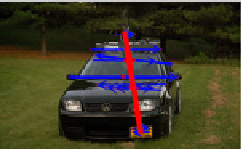Information Technology Reference
In-Depth Information
(a)
(b)
(c)
(d)
(e)
(f)
(g)
(h)
(i)
Fig. 12
Symmetry analysis results. (a) and (c) are taken from the Caltech 256 database. (b)
depicts a Menorah cap badge (e) is an example of symmetry detection under affine distor-
tion. In (d) we notice a spurious correspondence having the same reflection axis as the true
symmetry. The SSA fails in (i) due to the detection of erroneous feature points.
5.2
Statistical Accuracy Analysis
In order to asses the SSA's accuracy and compare it to previous results over an im-
age dataset of substantial size, it was applied to detect the axes of symmetry in 1521
images from the BioID face database [Bio01]. This dataset was used by Loy and
Eklundh [LE06] and we follow their experiential setup. This dataset also contains
the locations of 20 facial feature points (eyes, mouth tips etc.) manually annotated
in each image. Those points are used to compute the ground truth symmetry axes.
Same as in [LE06], the axis of facial symmetry was considered detected if its
(
r
,
θ
)
parameters were within
of the ground truth, respectively. We
used 600 local features with 4 nearest-neighbors sampled progressively out of 1500
local features, created by a Hessian affine-invariant detector and SIFT descriptors.
We achieved an accuracy of
99.41%
that corresponds to having only
nine misde-
tected
symmetry axes. Those are depicted in Fig. 14. In those images the face area
is characterized by an insufficient number of feature points due to its low contrast,
compared to the background. Some successful detection examples are shown in
±
5pixelsand
±
5
◦











Search WWH ::

Custom Search